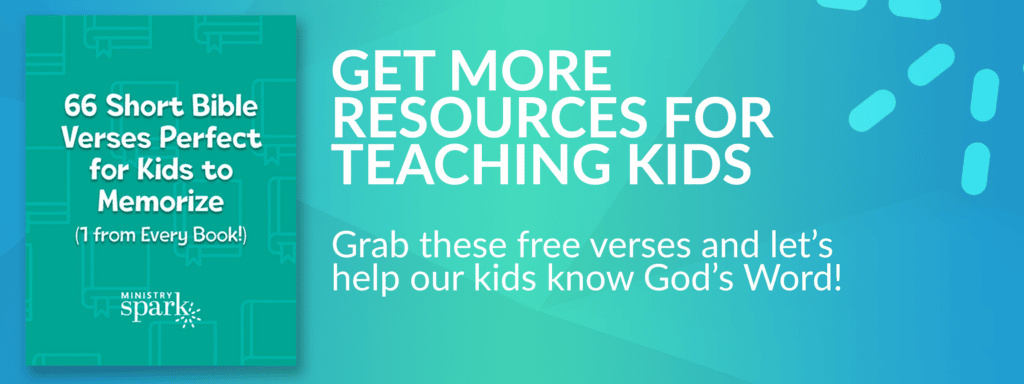It is so important that we encourage kids to pray. They can be pretty loud, yes. And it can seem like they never give you enough quiet to teach your lesson or take a moment to be silent.
And, yet, when we ask them to pray, sometimes they are at a loss for words.
That can feel awkward! Giving them tools and language for prayer can help it feel less scary.
How can we help our kids have confidence in approaching God, and assure them they are heard in this conversation with God?

There is a conversation I have every day with each of my kids. It always begins with, “What did you do at school today?” I ask my kids these questions because I genuinely want to know the good, the bad, and the ugly.
I have an intimate relationship with my kids, so they feel pretty safe telling me things that went well and things that didn’t go so well. We discuss all those things in our daily conversations.


Teaching Children to Confidently Pray
While almost every kid is comfortable in a conversation like that one, they might feel like they don’t have the right words to talk to God. They might feel like they don’t have a close enough relationship with God to be able to have a conversation with Him.
They may have an unhealthy fear of God or just be afraid that they might say the wrong thing.
Kids may not understand that prayer is simply a conversation with God—just like that daily conversation with a parent. God wants to be close to them and have an intimate and safe, trust-based relationship with them!
That’s why teaching kids in ways they learn is so important.
We both listen and talk when we have a conversation people. Taking time to both listen to God and talk to God is important too.
Talking to God reminds us that He is in control, He loves us, and He wants to be close to us. It’s all part of us having a relationship with Him.
Most kids who struggle with prayer question if they are being heard or if they have anything worth saying.
1 John 5:14 says, “This is the confidence we have in approaching God: that if we ask anything according to his will, he hears us.”
How can we help our kids have confidence in approaching God? How can we assure them they are heard in this conversation with God?
Here are 11 ideas for teaching the children you influence how to confidently pray! (And here’s 5 things to avoid!)

C.H.A.T. with God
We like to use the acronym C.H.A.T. to help our elementary aged kids learn more about prayer. It reminds them that it is not a scary thing—it’s a chat with God!
C Stands for Confession
Confession is when we tell God how we have sinned—the ways we have turned away from following Him.
By confessing to God, we show Him that we trust Him with everything. Knowing that He will still love us no matter what we confess, will in turn bring us closer to Him.
By confessing first in our prayers, we experience a closer relationship with God, and we know we can trust Him with our requests.
H Stands for Honor
God loves our worship. When we honor Him with our prayers—especially after confessing—it is pleasing to Him. We declare what we know to be true about Him!
Honor statements generally start with “God, you are ______.” And we tell Him truths we know about Him from the Bible!
A Stands for Ask
God says we can ask for anything in His name—and asking is usually the first thing we think of when it comes to prayer.
Asking is when we lay our requests before our God. This comes after we have built trust in confession and recalled His attributes in honor.
Often, kids can move to asking too fast, which can distract from the reverent posture we need to take through prayer.
T Stands for Thank
Saying thank you to God comes quite naturally to kids. Encouraging them to end their prayers with statements of thanks should be an easy way to encourage them as they pray!
Help kids think of things they can be thankful for. This could be anything from answers to asked prayers, things they see in nature, their family, and even small things that they delight in!
By breaking down the different parts of prayer, we help kids slow down. Then they can consider who they are talking to and why it is important to pray.
Prayer is a way to build relationship with God. Encouraging kids in this will help make them passionate about their faith.
4 Phrases for Preschoolers
Preschoolers may not fully understand the C.H.A.T. analogy. So to simplify it for them, you can use the phrases like these to help them remember how to pray:
- “I’m sorry”
- “I love you”
- “Please”
- “Thank you”
Put four pieces of paper up in your classroom space or home with one of those phrases listed on each.
Depending on the age and abilities of the kids you are working with, encourage them to draw or write their prayers on each of the papers.
For very young kids, consider using a sticker for each paper. They can simply stick one to the page each day they pray a prayer that fits one of those phrases.

Scripture Prayer
Find a prayer that was prayed in Scripture and print it out in a large font. Lay it on a coffee table or post it in a special place in your home or classroom. Put markers, crayons, or highlighters nearby.
As kids meditate on the posted Scripture, encourage them to use the markers to change the pronouns to make it personal for them, or to circle words or phrases that stick out to them.
An example is Philippians 1:9-11, “And this is my prayer: that your love may abound more and more in knowledge and depth of insight, so that you may be able to discern what is best and may be pure and blameless for the day of Christ, filled with the fruit of righteousness that comes through Jesus Christ—to the glory and praise of God.”
Your family might change the “you” to your family name. Or you might insert the names of the kids in your class.
You might write the definitions of some of the words around the words or highlight phrases like “your love may abound more and more.”
Prayer for the Outside/Prayer for the Inside
Use bathtub crayons or dry-erase markers to write on windows where we look outside!
You can also encourage kids to use bathtub crayons to write prayers for the people inside your house on bathtub and shower walls. This is a place where we often spend some uninterrupted time to pray.
Encourage kids to use the bathtub crayons to write prayers for people and things outside of their homes on the windows in their homes. Then when they look outside, they are reminded of what to pray.
In the classroom, you might use dry erase markers on a board to write prayer requests within the church. And you can use the markers on the windows to write names of people your kids are praying would come to church!
Google Map Prayers
Look up the satellite view of your church, your kids’ schools, or your kids’ houses.
Print them out or pass around your electronic device. While it is passed around the circle, each child can pray for something they see in the picture. They can pray for their home, their neighbors, their school, the church, or even other places people gather.
Head-to-Toe Prayer
To give kids a tangible way to talk with God, relate topics of prayer to different parts of their bodies. Have them point to their:
- Toes: Pray they would always walk in God’s paths and follow Him. Confess ways they might have strayed from God’s path.
- Knees: Confess when they haven’t knelt in prayer to God but have tried to do things on their own. Honor God with words they might use for a King as you are knelt down before Him.
- Tummy: Thank God for all He provides for us, including our food!
- Hands: Pray for the ways they could serve people, asking God to give them opportunities to serve neighbors and friends.
- Ears: Pray they would hear God’s voice above all others, and that they would listen to the needs of people around them.
- Mouth: Pray they would courageously speak God’s Word to those who need to hear it.
- Eyes: Pray they would seek God, and that God would give them eyes to see other people who may need to know they are known and loved by God.
- Head: Pray they would have the “mind of Christ” (1 Corinthians 2:16) and always consider others, think pure thoughts, and not be anxious or afraid. Children can also confess ways they may have not had the mind of Christ.
Prayer Webs
Play some quiet music and give each child a piece of paper and some colored pencils or crayons. In the center of their paper, instruct them to write a statement starting with “God is …”
As the music plays, kids are able to quietly pray and write (or draw) about who God is and the requests that are on their hearts.
They might draw or write about people they can pray for or things they can thank God for.
They can connect each new request to their “God is” statement in the center using colors and different line shapes, as it turns into a prayer web to remind them who God is.
Sticky Note Prayers
Lay out sticky notes on a table. Label three sections of a wall or a whiteboard with the titles “What to pray for,” “Prayed for,” and “Answered prayers.”
Have the kids in your class or the people in your family to write requests on the notes, one request per sticky note.
Stick the notes under the “What to pray for” title. As different people pray for each need, they can move the notes to the “Prayed for” section.
When the person who requested the prayer sees an answer, they are able to then move the sticky note into the “Answered prayers” heading!
Names of God Prayers
Find a list of the names of God that are used throughout Scripture. See if you can find at least one name per letter of the alphabet, although you might have to be creative with “x”.
Have kids sit in a circle and take turns praying one line each, using one of the names of God on the list.
As an example, you might pray, “Light of the World, I pray that people would look to you for hope when things feel dark.”
“It’s Not Fair” Prayer Letters
Kids can think of lots of things that seem unfair. One way to teach them how to pray prayers of lament is to have them write prayer letters to God.
Brainstorm some things that feel unfair to them—either personal experiences or issues they know about in the world. Invite kids to pour out their “it’s not fair prayers” to God in a letter, asking Him to fix it.
Explain that prayers of lament show that we understand things aren’t the way God intended them to be. As a result of your explanation, kids are reminded that it’s OK when we tell God that we trust Him to love us even when we don’t understand what He is doing.
Building Prayers
Using Legos or wood blocks, write one word or phrase of different lists of things in the Bible. Examples could be the fruit of the spirit, the final instructions in 1 Thessalonians 5, or Philippians 4:8 (all of the “whatevers”).
Build towers using those word blocks, praying for each of those things as you stack the next block. You might even unstack them and do it again. And this time pray for another person to experience those things.
It is so important that we encourage kids to pray and give them tools and language that help prayer to feel less scary to them.
And, while teaching kids about deeper relationship with God, don’t forget about your own! Sometimes we get so good at leading, that our own spiritual lives starts to stink.










